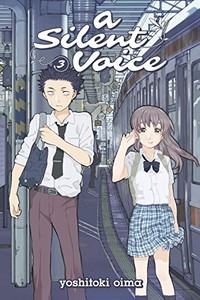Review
by Nick Creamer,A Silent Voice
GN 3
| Synopsis: |  |
||
Years ago, it was Shoya's bullying that led to his deaf classmate Shoko withdrawing from elementary school. Now nearing the end of his high school days, it's looking like his emerging friendship with the girl he once harassed will bring him out of his own shell. But Shoya still doesn't see a future for himself, and even when he's with Shoko, he can't bring himself to engage with her honestly as a friend. While both of them take hesitant steps forward, they're still far from bridging the gap that lies between them. |
|||
| Review: | |||
Welcome back to A Silent Voice, your source for good kids and sadness. In this third volume, we rejoin Shoya and Shoko as they attempt to make up for lost time, growing slowly closer in spite of hesitance on both sides. In Shoko's case, we see most of her desires secondhand, as a request to get back in touch with her old would-be friend Miyoko prompts Shoya to try and gather more friends for her. But on Shoya's side, we personally witness every insecure sigh and rationalized piece of antisocial behavior. There's no escaping Shoya's motives - this volume hangs even closer to his immediate emotional reality than either of the last two, and in doing so, it offers one of the most precise and captivating character studies in recent memory. This close character reading starts off early in the volume, with a shared train ride offering a great opportunity to hone in on Shoya's insecure body language around Shoko. The manga doesn't simply declare “this situation is awkward” - it uses a smart series of fidgety panels and consistent internal monologues to evoke the sense of Shoya pushing beyond himself to try and become comfortable around Shoko. Trying to guess her thoughts, doing his best to read very limited signals, and glumly wondering to himself “am I going to think like this every time I'm around Nishimiya?” - A Silent Voice's smart evocation of self-doubt places it head and shoulders above most similar dramas. Little asides like “since I didn't run into her today, I probably wasn't meant to find her,” or the ways Shoya always rushes to end his engagements with Shoko in spite of actually wanting to connect with her, all make this manga ring achingly true to a very specific experience of adolescence. The reintroduction of Miyoko into the narrative offers a strong counterpoint to Shoya's insecurities, and highlights the limitations of his relationship with Shoko. While Shoya swallows his questions and acts in whatever way he thinks is least likely to upset Shoko, the boisterous Miyoko actually treats her like a person, quizzing her on her daily life and taking the group out to karaoke. A Silent Voice's messages here are natural and well-considered – tackling the idea of Shoya thinking he can “protect” Shoko head on, the manga instead portrays his concern as reflecting a failure to respect and trust in Shoko's own agency. For his part, while Shoya feels jealous about how easily Miyoko breaks through the barriers he struggles with, he ultimately confesses the awful details of his elementary school behavior to her, not letting his past be forgotten. Shoya still idealizes Shoko in an unhealthy way, but this doesn't make him a “bad person.” Instead of either condemning or lionizing Shoya's behavior, A Silent Voice presents him as what he is – a troubled, insecure, and often mistaken teenager who's nevertheless consistently trying to do the right thing. The second half of this volume reintroduces Naoka, the abrasive girl who once enabled Shoya's bullying. In contrast to the ways Miyoko has grown out of her original personality, Naoka seems caught up in the past, still eager to bully those she can control and still infatuated with Shoya's old self. Though Naoka's an unrepentant troublemaker, her appearance ends up highlighting more of the issues in Shoya's behavior. His inability to deal with conflict prompts more trouble between Naoka and Shoko, but through her consistent prodding, Naoka is eventually able to make him admit to some of his own feelings. Though Naoka herself doesn't really gain much texture in this volume, her interactions with Shoya make for a strong counterpoint to his usual reticence, pushing him forward even if purely through anger. A Silent Voice's drawings are solidly up to the task of conveying this manga's tiny little character moments. Diverse expressions and strong body language do a great job of evoking the relative insecurities of Shoya and Shoko, and Naoka's introduction makes strong use of paneling to create some solid dramatic peaks. There's a looseness to the expression work that sometimes makes it seem like characters aren't quite portraying the emotion they're feeling, but overall the art is a worthy complement to the storytelling. The writing is the star at the moment, but “a bit worse than the writing in one of the best-written adolescent dramas out there” is not a bad place to be. Overall, A Silent Voice's third volume actually does the most yet with the least narrative material, tightly reigning its focus into a few key interactions in order to brilliantly capture a very specific emotional reality. It's one of the best good kids and sadness stories out there. |
| Grade: | |||
|
Overall : A
Story : A
Art : B+
+ Dialogue, internal monologues, and body language all come together to paint an incredibly acute portrait of adolescent anxiety. |
|||
| discuss this in the forum (2 posts) | | |||
| Production Info: | ||
|
Full encyclopedia details about Release information about |
||